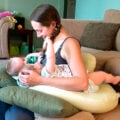One of the most exciting times of a woman’s pregnancy is decorating her baby’s nursery. Like so many new mothers-to-be, I spent hours researching the safest car seats, cribs and toys.
I baby-proofed everything in the house. When it came time to convert our spare bedroom into a nursery for our soon-to-be-born daughter, I knew not to use conventional paint, but to buy low VOC (volatile organic compounds).
I knew to avoid BPA (bisphenol-A), which wasn’t hard, considering almost everything is marketed as “BPA free.”
What I didn’t know was that a hidden threat lurked in our baby’s nursery furniture.
That ‘new furniture smell’
Determined to make the most of a small bedroom, my husband and I decided to forgo a full-size dresser for one of those faux wood closet systems, complete with cubbies and drawers, from a big-box home-improvement store.
My poor hubby spent the better part of a Sunday installing the closet, which we soon noticed was emitting a strong smell.
I’d heard that new furniture, much like a new car, could emit an odor. When the smell didn’t dissipate after leaving the windows open for a week, I decided to conduct a little online research by Googling “new furniture smell.”
What I learned made the hairs on the back of my neck stand at attention. The source of the odor was most likely formaldehyde — a volatile organic compound (VOC) used to cure particleboard, plywood and other composite wood products — and it can be toxic.
According to the U.S. Environmental Protection Agency and World Health Organization, formaldehyde is a carcinogen that can trigger health problems such as asthma, even at low levels.
The closet system we had purchased was made of a combination of laminated hard wood and particleboard. Our new changing table had particleboard shelves. Both most certainly contained formaldehyde.
How much is too much?
I wondered: How high was the formaldehyde concentration in our baby’s room? Was it high enough to be a health risk? There was only one way to know for sure: I ordered a home formaldehyde test.
Yes, they make those. I got mine online for around $30, including results, from Advanced Chemical Sensors at acsbadge.com.
The test itself was relatively simple. I clipped a small test badge to the bedroom closet door. After 48 hours, I placed the badge in the return envelope and mailed it back to the lab.
A week later, I received the results. My daughter’s nursery had a formaldehyde concentration of .08 parts per million (ppm). To put this in context, the EPA and American Lung Association recommend a maximum level of 0.1 ppm for indoor air. Although our test result was two points below the maximum level for indoor air, it was eight points above our comfort level.
We returned the closet and changing table the next morning.
Much of the Mortimer’s nursery decor, including this lamp and picture frame, were purchased second-hand on Craigslist. They used no-VOC Colorhouse paint to cover the walls.
Health effects vary
According to David Bell, a research scientist with Minnesota Department of Health’s Environmental Surveillance and Assessment Division, formaldehyde can be found in everything from synthetic fabrics to cosmetics.
It’s used in composite wood products and is present in trace amounts in real wood. Health effects from formaldehyde and other VOCs vary by individual, but can include headaches, dizziness and nausea.
“Generally speaking, these symptoms can occur at indoor-air concentrations greater than 0.1 ppm,” Bell said. “However, there is evidence that certain individuals can develop a sensitivity to formaldehyde and experience symptoms at lower concentrations.”
To be on the safe side, Bell recommends airing-out products suspected of containing formaldehyde before bringing them into your home — or, better yet, avoiding formaldehyde-containing products altogether.
“The problem is that, in the United States, there is no one formaldehyde-emission standard by which all manufacturers must abide,” Bell said. “California has the most stringent standards, and while many manufacturers adhere to those standards — so they can sell their products in all 50 states — not all do.”
The EPA is currently in the process of setting a national standard similar to California’s. The standard doesn’t ban the use of formaldehyde, but sets limits on the amount that can be emitted from wood products.
Looking to avoid off-gassing chemicals often found in composite wood furniture, the Mortimer family of White Bear Lake chose a Jenny Lind crib and changing table made of solid pine. The crib is also Greenguard certified, which means it meets some of the most rigorous standards for emissions of volatile organic compounds (VOCs). Together the pieces, purchased on Amazon, cost about $300.
Minnesota taking action
Minnesota legislators have been working to reduce formaldehyde in children’s products.
In 2011, formaldehyde was named to Minnesota’s Priority Chemical List through the Toxic-Free Kids Act.
Then, in 2013, the Minnesota State Legislature passed a bill banning formaldehyde in kids’ body products. The first phase of that bill went into effect in August 2014.
“Minnesota has really been a leader in protecting kids,” said Kim Labo, an organizer with Healthy Legacy, a coalition working to reduce toxic chemicals in consumer products in Minnesota. “We were the first state in the nation to prohibit formaldehyde-releasing chemicals in children’s body products.”
Flame retardants in upholstered furniture and other products are next on the agenda for Healthy Legacy.
Labo said the coalition would also like to see laws change at the federal level, where there are chemical-control regulations that haven’t been updated since 1975, when 60,000 chemicals were “grandfathered in” and another 17,000 were approved without investigation because they involved “trade secrets,” Labo said.
“State action in Minnesota and other states has really pushed this issue,” Labo said. “It’s putting pressure on the federal government to act.”
Creating a nontoxic nursery
A freshly painted and furnished nursery can contain up to 300 toxic chemicals, according to Healthy Child Healthy World, a California-based, nonprofit organization working to protect children from harmful chemicals.
The result?
The air in your home may be two to five times more polluted than outdoor air, and, in some cases, as much as 100 times more polluted than outdoor air, according to the Environmental Protection Agency.
So what’s a parent to do? First, don’t panic. There are plenty of ways to improve the air you breathe and reduce the amount of chemicals you bring into your home:
- Avoid smoking inside your home. Children are especially sensitive to secondhand smoke, which can trigger asthma and other respiratory illnesses.
- Allow products that may contain formaldehyde to off-gas. Leave the products in your garage or ask the manufacturer to leave the unsealed products in their warehouse for a few days.
- When possible, purchase real-wood furniture or gently used furniture that’s already had time to off-gas.
- Make fresh air your best friend. Increase ventilation by opening windows or using a central ventilation system. Be sure to conduct home renovations (which often involve chemicals and dust) when the weather is mild — such as late spring or early fall — when windows can be opened.
- Use a vacuum with a HEPA filter or invest in a central vacuum system. Staying on top of dust and dust mites can dramatically improve indoor air quality.
- Invest in a safe crib mattress. Look for one made from untreated natural fibers and that isn’t wrapped in polyvinyl chloride (PVC) — a source of phthalates (another set of questionable chemicals) — and that hasn’t been treated with traditional chemical flame retardants.
- When buying products, avoid polyurethane foam, which is often treated with chemical flame retardants. If the label says: “This article meets the flammability requirements of California Technical Bulletin 117,” it likely contains added flame retardants to meet low-flammability standards.
- Choose no- or low-VOC paint. Traditional paints contain harmful VOCs.
The crib mattress — made of organic cotton by Naturepedic — was a splurge for the Mortimers. They chose organic cotton as an alternative to synthetic fabrics and foams. The mattress is free of flame retardants and has a waterproof cover made of polyethylene, a safer alternative to a traditional PVC cover.
Resources
Our Healthy Homes Minnesota
For more tips on how to improve the air in your home, visit the Minnesota Department of Health’s website.
Healthy Legacy
This Minnesota-based coalition of local organizations has been working since 2006 to reshape chemical policy in Minnesota to protect public health. See healthylegacy.org. Call 612-627-1513 to schedule a Healthy Home presentation for your parenting or community group to learn more about how to find safe products and avoid unnecessary chemicals in consumer products.
Flame Retardants
Learn the history (and the problems) with flame retardants in the U.S. here.
The Mortimers’ solid wood glider was purchased secondhand. Since foam cushioning is often treated with flame retardants, they replaced the foam in the glider with 100 percent polyester fiber fill from a local fabric store. The Oeuf changing table pad is made from renewable plant-based foam that’s free of chemical flame retardants.

















